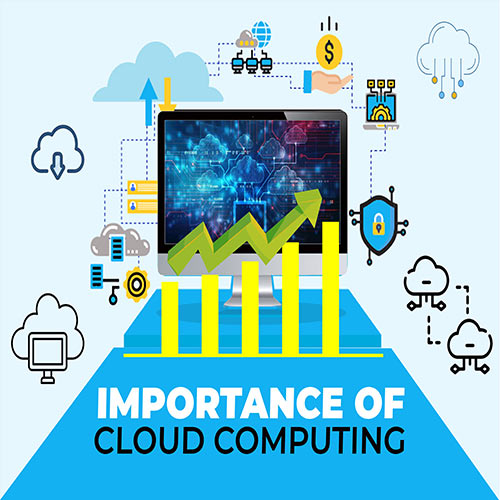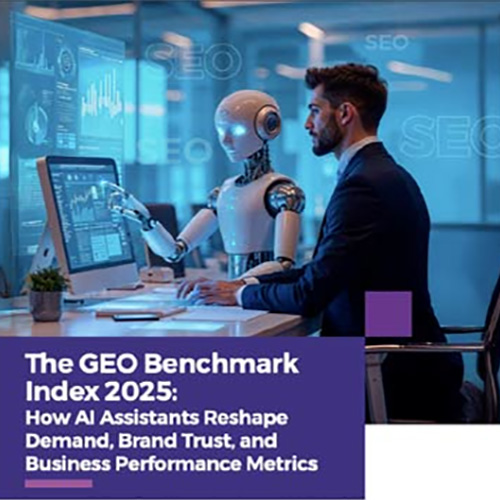
With organizations embarking on a digital transformation journey to accelerate business growth, cloud computing is serving as a fundamental pillar for them in this journey. The cloud aims to enhance their agility and innovation, ultimately leading to improved time to market and competitive advantage, besides providing on-demand access to various IT services. However, with the emergence of generative AI and various LLM toolkits, AI Cloud is touted to be the next big thing -
Organizations today are starting to look at adopting a cloud-first, innovation-driven, and automation-focused mindset to achieve business agility and growth. After many years of businesses trying to integrate cloud technologies into their operations, the cloud has finally evolved far beyond its original purpose as infrastructure and has become a foundation for digital transformation initiatives. This has been possible as organizations now increasingly realize the power of cloud technology accelerating time to market, helping to innovate, reducing risk and impacting other business areas as they move beyond the initial phase.
 “Cloud computing provides a range of benefits for businesses, including lower costs, pay-for-use, rapid elasticity, scalability, and resilience. Cloud-based collaboration tools integrated with specialized AI enhance teamwork across geographically dispersed teams and streamlined business processes,” observes Pamela Kundu, Senior Director, Sales Engineering, UiPath. “Cloud computing can facilitate faster deployment of applications, services, and infrastructure, which enables businesses to be more responsive to changing market demands for new growth avenues. Assisting this process, specialized AI provides a seamless user experience by ensuring that applications can handle traffic fluctuations without manual intervention.”
“Cloud computing provides a range of benefits for businesses, including lower costs, pay-for-use, rapid elasticity, scalability, and resilience. Cloud-based collaboration tools integrated with specialized AI enhance teamwork across geographically dispersed teams and streamlined business processes,” observes Pamela Kundu, Senior Director, Sales Engineering, UiPath. “Cloud computing can facilitate faster deployment of applications, services, and infrastructure, which enables businesses to be more responsive to changing market demands for new growth avenues. Assisting this process, specialized AI provides a seamless user experience by ensuring that applications can handle traffic fluctuations without manual intervention.”
 “Cloud computing has emerged as a game-changer in the business world, revolutionizing the way organizations operate and helping them accelerate business growth,” says Sumed Marwaha, Managing Director, Unisys India. “Our recent study, “From Barriers to Breakthroughs: Unlocking Growth Opportunities with Cloud–Enabled Innovation,” focuses on how companies have advanced by implementing digital transformation technologies, such as cloud computing, data analytics and artificial intelligence.”
“Cloud computing has emerged as a game-changer in the business world, revolutionizing the way organizations operate and helping them accelerate business growth,” says Sumed Marwaha, Managing Director, Unisys India. “Our recent study, “From Barriers to Breakthroughs: Unlocking Growth Opportunities with Cloud–Enabled Innovation,” focuses on how companies have advanced by implementing digital transformation technologies, such as cloud computing, data analytics and artificial intelligence.”
 “There's a reason why we call the present world scenario hyper-connected,” says Piyush Somani, Chairman & Managing Director-ESDS Software Solution Ltd. & President- CCICI. “We can't even think of the business world working in complete silos anymore, as remote working, live updates, or streaming are some fundamental changes cloud computing has brought about. But these are just a few of the facial changes in businesses that we notice. If we go deep down, cloud computing has enabled businesses to elevate their efficiency, scalability, and agility while streamlining operations and cutting costs.”
“There's a reason why we call the present world scenario hyper-connected,” says Piyush Somani, Chairman & Managing Director-ESDS Software Solution Ltd. & President- CCICI. “We can't even think of the business world working in complete silos anymore, as remote working, live updates, or streaming are some fundamental changes cloud computing has brought about. But these are just a few of the facial changes in businesses that we notice. If we go deep down, cloud computing has enabled businesses to elevate their efficiency, scalability, and agility while streamlining operations and cutting costs.”
The recent McKinsey survey is enough to substantiate that cloud adoption has yielded substantial benefits for companies, with over 40% of respondents agreeing to achieve the expected advantages fully. These benefits include improved service levels, witnessed by 43% of companies, while 45% experienced enhanced business enablement, and 42% achieved better business continuity through cloud adoption. Besides this, cloud computing has empowered businesses with seamless adaptations to market demands and facilitated expansion without the burden of expensive infrastructure investments.
 Sanjay Agrawal, Technology Head, Hitachi Vantara points out that cloud computing also offers an economically viable alternative for companies by providing seamless access to computing power, storage and an array of software programmes when demands are ad-hoc and unpredictable. “It enables businesses to swiftly roll out new services and products, thereby resulting in customer acquisition and establishing a competitive advantage. Cloud computing also relieves businesses from the burden of making substantial infrastructure investments, liberating them to focus their resources and efforts on core competencies while simplifying the complexities associated with data administration.”
Sanjay Agrawal, Technology Head, Hitachi Vantara points out that cloud computing also offers an economically viable alternative for companies by providing seamless access to computing power, storage and an array of software programmes when demands are ad-hoc and unpredictable. “It enables businesses to swiftly roll out new services and products, thereby resulting in customer acquisition and establishing a competitive advantage. Cloud computing also relieves businesses from the burden of making substantial infrastructure investments, liberating them to focus their resources and efforts on core competencies while simplifying the complexities associated with data administration.”
The survey done by Unisys, which gathered responses from 2,264 businesses and technology leaders across four regions, found that companies are determined to prioritize investments in digital capabilities to drive growth and manage costs simultaneously. According to the survey findings, in order to drive value, organizations must overcome challenges, such as lack of strategic alignment, governance issues, complex technological landscapes, skills gaps, incompatible operating models and heightened levels of risk. Investing in technology alone is not enough; successful long-term adoption requires full and thoughtful integration and careful management of technology’s role within an organization.
“There are two key dimensions to cloud adoption challenges. The first is on the technological side, such as data warehousing, data privacy governance and compliance, data security, retrieval and administration, operations and optimization of hybrid cloud management. These obstacles can be addressed as technology evolves,” explains Sumed.
Costs can also be daunting for businesses as they often face challenges with FinOps, a cloud financial management method focused on maximizing corporate value. It is common for organizations to use the cloud throughout different departments, but the Chief Information Officers and the Chief Financial Officers face challenges because they do not have a clear understanding of cloud spending at an organizational level. This requires a clear FinOps strategy to manage their cloud expenses proactively and reactively.
CLOUD REPATRIATION VS CLOUD ADOPTION
The assertion that public cloud workloads will migrate back to on-premise environments in the coming year is largely speculated. It is important to note that the repatriation of workloads is not a one-size-fits-all solution. While some businesses may adopt hybrid cloud approaches that combine public and on-premise infrastructure for specific purposes, the overall trend continues to favour increased adoption of cloud computing.
 “Public clouds offer scalability, flexibility, and access to a wide range of services and technologies. They provide convenience and cost-effectiveness that are challenging to replicate with on-premise solutions. While certain industries or specific use cases may necessitate on-premise infrastructure, the majority of businesses recognize the advantages of cloud computing and will persist in migrating workloads to the public cloud,” contends Srividya Kannan, Founder & CEO, Avaali Solutions.
“Public clouds offer scalability, flexibility, and access to a wide range of services and technologies. They provide convenience and cost-effectiveness that are challenging to replicate with on-premise solutions. While certain industries or specific use cases may necessitate on-premise infrastructure, the majority of businesses recognize the advantages of cloud computing and will persist in migrating workloads to the public cloud,” contends Srividya Kannan, Founder & CEO, Avaali Solutions.
In India, cloud infrastructure is still costly for businesses. But this doesn't necessarily mean that they will revert to on-premises data storage anytime soon. Research shows that many organizations still find hybrid cloud model as the right approach as it brings an optimal balance of flexibility, scalability, and security while keeping data privacy concerns in mind. This allows organizations to leverage the benefits of the cloud while keeping certain workloads on-premises for specific requirements.
“Every technology has pros and cons, and organizations must carefully weigh them before making decisions. The adoption of public cloud services has increased due to various factors, such as security, scalability and flexibility. However, growing concerns about data exposure on the public cloud may lead organizations to rethink their cloud strategy, especially those dealing with personally identifiable information (PII), critical data and intellectual properties,” observes Sumed.
Says Piyush of ESDS Software Solution Ltd., “The ongoing discussions on repatriating workloads from the public cloud to on-premise have intrigued me, but the feasibility still needs to be explained.”
He further points out that a study conducted by leading technology research firm, Gartner, reveals that despite economic challenges faced by major economies, cloud spending has shown remarkable growth.
“In fact, the global public cloud services market is projected to grow by 23.1%, reaching a value of $332.3 billion. Moreover, the supply chain disruptions and shortages of hardware and semiconductors have compelled organizations to seek alternative solutions, which has played a role in the accelerated adoption of cloud services,” cites Piyush.
“According to IDC, organizations' investments in cloud infrastructure and platform services increased by 35.3% in recent years, demonstrating their confidence in cloud solutions amidst supply chain constraints. As businesses strive to optimize their IT infrastructure while focusing on industry compliances and specific requirements, tailored cloud services have witnessed a surge in demand. Research conducted by Flexera, a software management solutions provider, reports that 59% of organizations actively work on cloud cost optimization initiatives, indicating a strategic shift towards more tailored and cost-effective cloud solutions. This aligns with the rising trends in community or vertical cloud demands, where organizations seek cloud services that cater specifically to their industry needs,” he adds.
 A variety of factors can influence the decision to move workloads to an on-premise environment. These considerations may include the need to comply with data security and compliance regulations, a preference for greater control over sensitive data, and an assessment of the cost implications for specific workloads. Sudhir Kunder, Country Director, DE-CIX India puts forth an example in which he cites that in order to modernize its infrastructure, a government agency responsible for managing classified information and data, and adhering to stringent data sovereignty regulations, made the decision to transfer a portion of its workloads to a public cloud environment. “Nevertheless, as a result of apprehensions regarding unauthorized access and data breaches, the organization opts to relocate these workloads to an on-premise environment. This decision is driven by the desire to exert greater control over security measures and ensure adherence to specific data handling protocols in order to maintain compliance,” he says.
A variety of factors can influence the decision to move workloads to an on-premise environment. These considerations may include the need to comply with data security and compliance regulations, a preference for greater control over sensitive data, and an assessment of the cost implications for specific workloads. Sudhir Kunder, Country Director, DE-CIX India puts forth an example in which he cites that in order to modernize its infrastructure, a government agency responsible for managing classified information and data, and adhering to stringent data sovereignty regulations, made the decision to transfer a portion of its workloads to a public cloud environment. “Nevertheless, as a result of apprehensions regarding unauthorized access and data breaches, the organization opts to relocate these workloads to an on-premise environment. This decision is driven by the desire to exert greater control over security measures and ensure adherence to specific data handling protocols in order to maintain compliance,” he says.
Sanjay of Hitachi Vantara however has a different view. “It's true that many workloads on the public cloud may move back to on-premises very soon in order to maintain the right balance and cost-effectiveness,” he says. “Workloads that require frequent data access may have to pay hefty egress fees, which detracts from the public cloud's appeal. Similar to this, some workloads that use IT resources consistently and do not anticipate ad hoc or unpredictable demands requiring significant IT resources do not require the agility and scale that public cloud infrastructure offers, and in many instances, these workloads may end up costing more than on-premise counterparts. Many of these workloads might not be appropriate for the public cloud, and they will probably return to on-premise IT.”
Sanjay further says that it is advisable that organizations conduct a workload portfolio assessment first and then move the workloads to the public cloud as a result. “This will allow for an educated decision and prevent the need for repatriation in the future. This guarantees a balanced approach to the deployment of the cloud. It goes without saying that repatriation is not a simple process and does have additional costs in addition to occasionally disrupting business.”
AI & CLOUD
Cloud-based AI platforms are vital for supporting generative AI models and AI-powered automation, driving the cloud market’s growth by providing access to vast amounts of data stored in the cloud, crucial for effective training decision-making and high-performance computing and resources.
Cloud providers are increasingly leveraging LLMs to offer generative AI as scalable, cloud-based services, enabling them to manage varying workloads and accommodate growth. These services are made accessible through APIs or pre-built tools for integration, regardless of location.
“The combination of large language models (LLMs) and cloud computing infrastructure offers processing power, accessibility, and optimization to support generative AI and AI-powered automation,” says Pamela of UiPath. “Consequently, businesses can integrate generative AI without significant upfront investments or infrastructure complexities. This integration of generative AI, AI-powered automation, and cloud-based solutions drive innovation and emphasizes the potential for AI Cloud as the future of AI-driven technologies.”
Sumed explains that as the AI cloud market continues to expand, driven by advancements in LLMs and increasing adoption, it holds immense potential for transforming industries and shaping the future of AI.
“Cloud-based generative AI services accelerate AI-driven application development across industries, enhancing customer experiences, automating tasks, generating content at scale, and improving decision-making. Moreover, they facilitate collaboration, integration and utilization of advanced AI capabilities without requiring extensive in-house expertise, democratizing AI access for organizations of all sizes,” he says.
However, he further adds that it is crucial to prioritize ethical considerations and responsible AI deployment to ensure the AI cloud's sustainable growth and beneficial impact. “While generative AI in the cloud demonstrates impressive capabilities, the following concerns have been and continue to emerge, which in turn amplifies biases: ethical considerations, artificial hallucinations and accuracy of the responses, and data privacy and security while handling large datasets.”
While the technology evolves, experts have found that using controlled generative AI models where the environment and data are well-defined and restricted can benefit organizations. Generative AI systems can be designed and trained to operate within these constraints, leading to more predictable and reliable outcomes and avoiding inaccuracies and hallucinations.
Almost every vendor comes up to the conclusion that the future of cloud computing lies in AI Cloud. “As AI and machine learning evolve, businesses increasingly rely on cloud infrastructure and services to harness AI's exceptional power. Cloud providers offer efficient and cost-effective computational resources and storage, catering to the demanding requirements of AI workloads,” states Srividya of Avaali Solutions.
With AI's growing prominence across industries, the demand for AI Cloud solutions will surge. This enables businesses to drive innovation, gain a competitive edge, and deliver transformative AI-powered products and services to customers.
As Sudhir of DE-CIX India points it out, while AI in the cloud is expected to assume a vital role, alternate AI deployment methods like edge AI (processing data on local devices) and hybrid AI architectures may also gain traction based on specific use cases and technological advancements.
The use of generative AI in conjunction with LLMs has therefore emerged as a significant catalyst within the cloud market.
See What’s Next in Tech With the Fast Forward Newsletter
Tweets From @varindiamag
Nothing to see here - yet
When they Tweet, their Tweets will show up here.





























